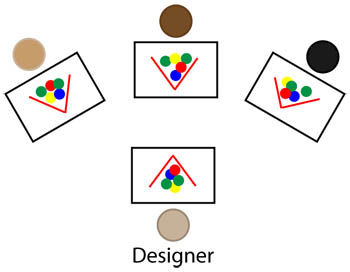Copyright © University of Cambridge. All rights reserved.
'En-counters' printed from https://nrich.maths.org/
Show menu
Why do this problem?
This task encourages the development of team-building skills such as helping others to do things for themselves, responding to the needs of others, encouraging everbody to help each other and explaining to each other by telling how. This is one of a series of problems designed to develop learners' team-working skills. Other tasks in the
series can be found by going to this article.
In addition learners will gain experience at using words to describe position and orientation.
Possible approach
A team has four or more members.
You may wish to use an adult as an observer.
Before starting this practical activity you might wish to ask each member of the group to draw their design, ready for when they act as designer for the rest of the team. You may wish to constrain the range of possibilities to manage the difficulty level of the task. For example:
- The designer has up to 12 counters of different colours and arranges them in a row - each counter touching the one or two counters on either side of it. They might describe their pattern in terms of "Start with blue, place a blue counter to its right, now a yellow to its right" or "Start with a red, place a yellow below then a blue below that".

- The designer can use two dimensional arrays. They might then describe their pattern in terms of "You need two blue and two yellow counters. Make a square where the blue counters are in the top right and bottom left and the yellow in the top left and bottom right".
The focus of attention for the teams is asking, explaining and helping each other. The completion of the task, whilst rewarding for all concerned, is not the main purpose of the activity.
If learners need some support with their positional language, a word list can be found here: word, pdf.
When teams have finished working on the task it is important that they spend time discussing in groups, and then as a whole class, how well they worked as a team. They can consider what they have learned from the experience and what they would do differently next time, particularly in terms of how to ask questions and answer them effectively. Your own observations, as well as those of observers, might inform the discussions.
Why not let us know how the children have got on with their group-working skills by clicking on the 'Submit a solution' link?
Key questions
Were there any questions that someone else asked that you found helpful?
How well did you listen to others in your group?
How easy was it to use the answers to the questions that were asked?
Was there an answer that you found particularly helpful?
Possible extension
Learners may like to try one of the other 'Explaining How' tasks. Other team-building tasks can be found by going to this article.
Possible support
Other team-building tasks can be found by going to this article.
